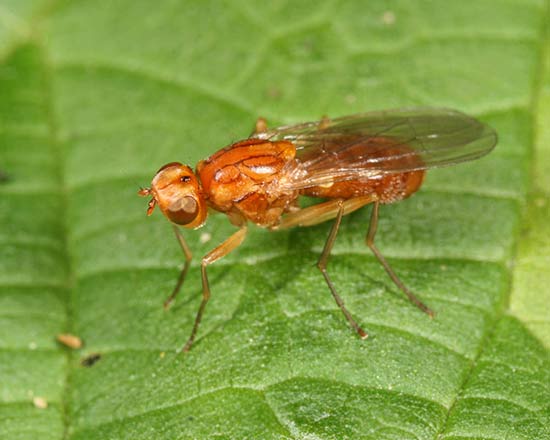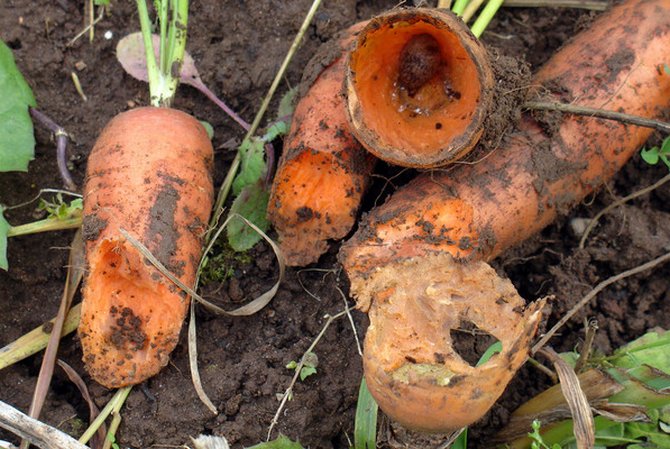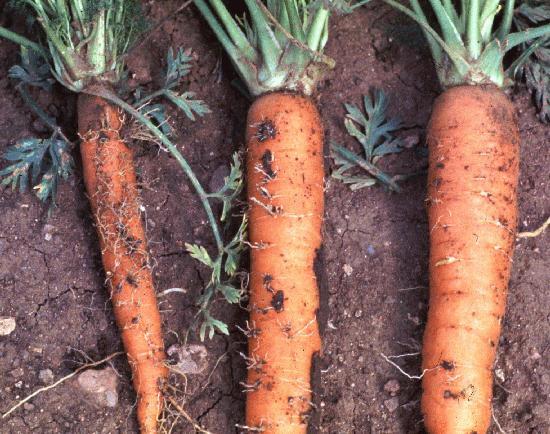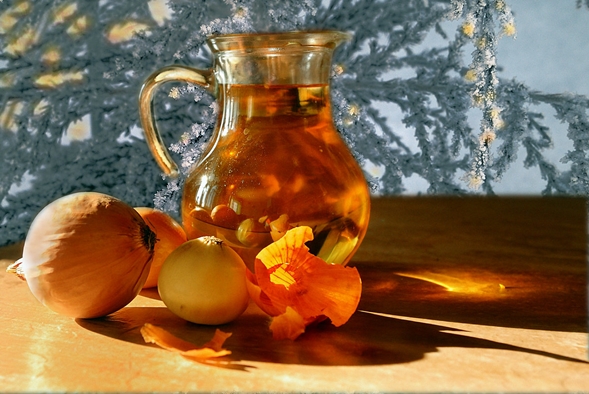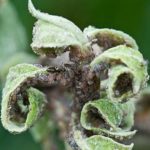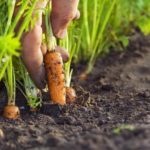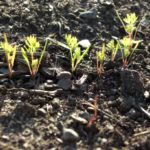Carrot pests love to feast on the sweet root crop, exposing the tasty pulp to various damage. If you don’t think through control methods, you won’t be able to get a harvest of tasty fruits in the fall.
- Carrot fly: what it is and how to get rid of it
- Description of carrot psyllid
- Umbrella moth: what harm it causes, how to fight
- Clams on a carrot bed
- Wireworm is the enemy of root crops
- Carrot aphid: harm, fight against it
- Armyworm caterpillars: how to deal with them
- How to fight whitefly
- The best chemicals for pest control, rules for their use
- Traditional medicine recipes against pests
It’s rare that some insect doesn’t fly into the garden and loves to feast on juicy carrots and their fragrant tops.The specific smell attracts pests, which is why there are a lot of them in carrot beds. You can save the plant if you know the pests by sight and understand how to deal with them.
Carrot fly: what it is and how to get rid of it
One of the common pests of carrot beds is onion fly – is not dangerous in itself. But on warm spring days, it lays larvae in the ground, which gnaw tunnels in the pulp of the root crop. Leaving their waste products inside the carrots, the larvae make the vegetable unsuitable for food. It tastes bitter and has a putrid odor. Red-violet spots appear on the leaves of the plant.
After a fly attack, carrot diseases appear on the vegetable more often.
Since the enemy is hiding in the soil, attacking vegetable crops from there, it is impossible to deal with it with chemicals. But it’s possible to destroy it using folk remedies. To repel flies, marigolds, onions, and cilantro are planted next to carrot beds. And spraying the soil and plants with a solution of ash and tobacco dust after loosening will lead to the destruction of the larvae.
For preventive purposes, it is necessary to regularly loosen the soil between the rows, thin out the seedlings, avoiding dense plantings. In the fall, after harvesting, garbage and plant debris are removed, burned, and the soil is dug up.
Description of carrot psyllid
The carrot psyllid is a small insect that lays eggs in the ground. If there are coniferous trees near the garden, then it is difficult to protect carrots from psyllids. Both adults and larvae cause harm by sucking the juices from the root crop. After being attacked by a pest, a vegetable becomes tasteless, hard, and the carrot tops begin to curl.
Chemicals - Intavir, Actellik - repel insects. Treatment is carried out twice: in early May, in June.
Among folk remedies, carrot psyllid is afraid of infusion of tobacco leaves and ash.
To prevent the appearance of pests, follow the rules growing and caring for carrots. In the fall, it is necessary to deep plow the garden, and disinfect the seeds in a solution of potassium permanganate before sowing. If there are growing conifers nearby, they are treated with Karbofos.
Umbrella moth: what harm it causes, how to fight
If you find brown caterpillars on the leaves and in the garden bed, this means that carrot pests such as umbrella moths have appeared. By entwining the testes in the form of cocoons, the moth caterpillars move onto the fruits. The greenery of the plant begins to turn brown and dry out, and the growing season of the vegetable crop stops. The pest is especially active in mid-summer. Later he poses no threat.
Methods for exterminating umbrella moths are reduced to spraying with drugs - Entobacterin, Lepidocide.
Mechanical trimming of umbrellas along with cocoons and their subsequent destruction will also help to cope with caterpillars.
Clams on a carrot bed
Worm-like mollusks include naked slugs that infect everything that gets in their way. Carrot leaves, roots, and seed umbels are eaten. During the day, slugs hide in damp places and come out to hunt in the evening. You can notice their presence by the whitish mucus they leave on the ground. To eliminate the pest, you need to treat the carrots with copper sulfate or superphosphate. An effective product is Metaldehyde in granular form.
Molluscs will never appear on plants treated with tincture of hot pepper with the addition of laundry soap shavings.
Prevention will include weeding the beds and clearing them of plant debris. Since slugs love moist soils, it is necessary to water the beds moderately without making them waterlogged.
Wireworm is the enemy of root crops
The larvae of click beetles are called wireworms because they are a yellowish, elastic worm. Pests appear at the end of May, feeding on the pulp of not only carrots, but also potatoes and beets. You can find out who is eating carrots by looking at the burrows in the fruit, yellowness, and wilting of the tops.
Pest control measures consist of the use of drugs such as Aktara, Etonem. Products based on ammonia can save you from wireworms. Sprinkle the ground with lime, which helps get rid of wireworms.
Pest baits are also effective. This folk remedy consists of burying pieces of vegetables - potatoes, carrots, beets - in the ground. And after a week or two, they are collected together with the wireworm and destroyed.
Carrot aphid: harm, fight against it
The stems and leaves of the plant, strewn with small light green insects, often die because aphids suck the juices out of them completely. At the initial stages of damage, the development and growth of the vegetable crop slows down and it begins to wither. Sweetish secretions from aphids can be found on the stems and leaves. Insect activity leads to fungal diseases.
How to fight aphids has been known for a long time. The best method is to treat with a soap solution with the addition of kerosene. Infusions of tobacco and ash are also effective. To repel insects, marigold plantings are used. Place pieces of onion and garlic between the beds and sprinkle with red pepper.
Prevention measures include organizing a shower for the plant. When watering, you need to spray the tops of the vegetable on top. This will help wash away any aphids that appear on the stems.
Armyworm caterpillars: how to deal with them
The winter cutworm, or cutworm, is quite harmless, but its caterpillars with a black stripe on their back can destroy the entire carrot crop. Insects called Trichogramma can protect the plant. Chemical preparations should be used to treat plantings with Decis and Polytrin. The best folk remedies are infusions of chamomile and burdock.
Prevent infection by caterpillars by proper care of vegetable crops and loosening the soil. Before planting, carrot seeds are treated with a solution of potassium permanganate.
How to fight whitefly
The midge is two centimeters in size, with whitish wings, similar in appearance to a moth, and is called a whitefly. The insect and its larvae feed on plant juices. The reasons for its appearance are humid and hot weather. The danger of the pest lies in its rapid reproduction. At the same time, the stems become covered with a sticky coating, attracting pathogenic fungi. Symptoms of the disease are expressed in blackening of the stem and its rotting. The process of photosynthesis slows down, and it will be difficult to save the plant. Using the example of whiteflies, a connection can be traced: carrot diseases arise from pests.
It's clear why this happens. Pests weaken the plant. If there is no fight against them, pathogenic fungi and bacteria penetrate into the root crops, ultimately destroying them.
The best chemicals for pest control, rules for their use
The chemical industry produces a large number of products that protect our gardens from pests. It's not difficult to understand them. Many are similar in method and principles of action:
- They fight wireworms, cutworms, and aphids using the drugs Grom, Barguzin, Zemlin. Their action is aimed at pests that multiply in the ground.
- Bison and Corado are based on the systemic insecticide imidacloprid.When it gets into plant cells, it kills harmful insects. Among them are aphids and whiteflies. A similar effect is typical for Aktara, which is used to control carrot pests.
- Broad-spectrum acaricide Karbofos, Actellik fights psyllids, aphids, and caterpillars. The drugs are low-toxic and are used in many subsidiary farms.
- Fitoverm is used when growing carrots both in open ground and in greenhouses. The effectiveness of the product becomes higher when used in warm and humid weather.
The toxicity of chemicals must be taken into account when using them against carrot pests:
- They are processed in accordance with the instructions, which indicate the acceptable dose.
- The best period for spraying will be early spring, before the fruit is harvested.
- Spray with insecticides in calm, windless weather, wearing gloves and a mask.
- Use special sprayers with a boom at least one meter long.
- The drug is diluted in a special container.
- After the procedure, no root crops are picked from the treated area. They will cause poisoning.
- As soon as the work is over, they wash their clothes and take a shower. The equipment is rinsed in water and vinegar.
Diseases and pests of carrots can be destroyed with chemicals, but they can harm domestic animals and beneficial insects. Therefore, they are used in extreme cases.
Traditional medicine recipes against pests
How to treat carrots to save them from pests - people have been thinking about this for a long time. Among the folk recipes that are effective:
- Infusion of garlic or onion. Two hundred grams of the product are cut and placed in a jar with two liters of warm water. Infusion occurs for a day. Before spraying, dilute in eight liters of water.Before pouring, shake the solution thoroughly.
- Tobacco decoction. A kilogram of tobacco dust or shag waste is diluted in half a bucket of water. After an hour of infusion, boil for 60 minutes. Leave the broth and filter. Then dilute it at the rate of half a liter of broth per bucket of water. It is useful to add green soap - one hundred grams.
- Soap solution. For it, take forty grams of laundry soap, turn it into shavings and fill it with warm water. It is good to water the plant with this infusion when spider mites and aphids eat it.
- Infusion of onion peel. Spraying them will help against pests and diseases. Twenty grams of husk are infused in one liter of water. Spray carrots against pests three times at intervals of ten days.
A major role in preventing pest attacks is played by proper crop rotation and adherence to the rules of vegetable care. Then there will be no problem of how to deal with unwanted guests of the carrot bed.
Growing a vegetable from sowing to harvest means putting maximum effort and attention to it. If the plant begins to wither and weakens, then knowledge of the symptoms of the disease, their description and treatment, as well as the types of carrot pests and the fight against them will help correct the situation. Then in the fall a mountain of juicy, healthy root vegetables awaits the patient owner.

